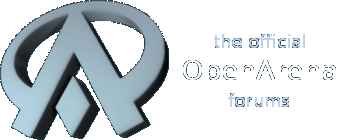ok, because of the amount of information that will be in this tut Im going to have to bust it up into multiple sections. I plan to cover the mapping process from the layout to the compile and final release. This is going to take several days to complete, so Im going to do this as a nightly thing until its finished. I will post stages of each day as I complete them.
So, we have ALOT to cover, so lets begin shall we. I will make an attempt to recreate this tut later in a screen cast.
Part1: (the layout)
Im not going to go into explicit detail about this part because ive already explained it in another tut.
please see
http://openarena.ws/board/index.php?topic=2507.0So ive started on a basic layout. With a layout you need to think strategy. A good level designer will not only have architecture on the brain but a "flow layout" as well. How will players be attracted from one room to the next. To make this idea abit more complicated, how to attract bots to this same area? For this tutorial, i didnt get real evolved with the entire layout process, I merely want to get the gears in your head turning around on their own so you can start building too.
So here are some shots



now take notice, its all "pink" (yours will probably be "blue". I use the default/custom set of commons.). Thats because its all entirely caulk. This is Extremely important. As i said in the other tut, this is important and for a very good reason. I guess now is the best time to dive off on this grueling subject.
Look at the wall nearest you. Can you see the other side? What about if you walk around to the other side. Can you see it? How about the inside of that same wall? Well, the game engine renders in alot of the same way, except one major difference. In a render, just because you cant see it, does not mean it does not exist. And if the engine can see it; it does exist, so it must be drawn. This doesn't matter if you can see it or not in game. SOOOO. If we dont need to see it, then it doesnt need to be drawn, so we use caulk for everything the player will never need to see. Caulk does not render. It is Solid, but also completely invisible.
So with that process in mind, lets refer to this idea as visible faces from now on.
The idea of visible faces is to keep as much of the world that is unseen from being drawn by the engine as possible. This is what causes low frame rates in maps. This is also what people are looking at when they say that a map is very poorly brushed.
*tip
You should look in the preferences in Radiant and make sure to set the option that clipper tool uses caulk.
Now we are doing this to develop a good habit here. Start ALL of your maps by using almost the entire common library. Dont rush it, and why would you get in a big hurry anyway, your having fun, so take your time. =).
Some more pics.


I know what your thinking. "WTH are you doing?". Well for me when i design a level its what ever im feeling at that moment. For this one, i decided lets do a Goth theme, and not just Goth but why not go turbo goth. Complete with grated platforms. Now I wanted the platforms to "actually have holes in them". There are other ways to accomplish this idea, but this is one of the easier ways.
So We start with no-draw. For the pool room, we have slime that will be underneath (that reminds me, the "Do Not Enter" is what I use a reminder to put a liquid or void there. Because we are using only commons, and NO shaders, I need something to remind me later.
So, lets create the shader for the grated walkway. Once the new grate shader is completed we'll start applying it to our grate. Now for this example I created a very simplistic shader. No image binding or use of detail shaders. Just a plain old vanilla example. I can do a shader tut later if needed.
Now when you apply the texture, you only need to apply to the side most visible to you. You can do this by holding ctrl+shift and then middle clicking the area to be textured. Again, im giving directions on this assuming you have read the 099 tut ive already posted.
Ok, more pictures.


And thats all the time I have for tonight. Tomorrow I'll go over some extra details on adding details to our grates and then making them solid once again, so we can walk on them =). Until then, I bid you good night, and keep practicing.
I have provided the files here. If you would like to follow along more in depth. The file pack will change each day as the sample map becomes more to life.


